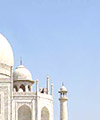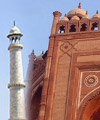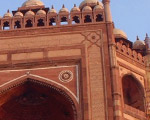|
Sarnath
 Sarnath
was called ISIPATNA and is situated 10 kms from Holy Hindu City
Varanasi. After Lord Buddha attained enlightenment he delivered
his first sermon called DHAMMA CHAKKA PAVATTANNA SUTTA to his five
former companions named Kondanna, Bhaddiya, Vappa, Mahanamma and
Assaji in the deer park at ISIPATNA, and soon after they attained
enlightenment. Latter Yasha (the son of wealthy merchant) and fifty
of his friends became monk after listening to Lord Buddha's sermon.
Lord Buddha sent them far and wide to spread Dhamma. Thus from here
the spreading of Dhamma commenced. Lord Buddha spent first rainy
season here after enlightenment. Sarnath
was called ISIPATNA and is situated 10 kms from Holy Hindu City
Varanasi. After Lord Buddha attained enlightenment he delivered
his first sermon called DHAMMA CHAKKA PAVATTANNA SUTTA to his five
former companions named Kondanna, Bhaddiya, Vappa, Mahanamma and
Assaji in the deer park at ISIPATNA, and soon after they attained
enlightenment. Latter Yasha (the son of wealthy merchant) and fifty
of his friends became monk after listening to Lord Buddha's sermon.
Lord Buddha sent them far and wide to spread Dhamma. Thus from here
the spreading of Dhamma commenced. Lord Buddha spent first rainy
season here after enlightenment.
The earliest remains here at Sarnath are from the Mauryan period
ascribed to Emperor Ashoka the great. The Lion Capital is the national
emblem of India. The Dharmarajika Stupa was built by Ashoka, and
it was expanded and enlarged several times upto the 12th century
CE. The structures here were destroyed by repeated invasions - and
by gradual neglect - and what are seen today are the results of
repeated reconstruction efforts. The Dhamekh stupa is a cylindrical
tower, 143 feet high, and 93 feet high. The stones in each layer
were bound together by iron clamps. This tower dates back to the
Gupta period. The Chinese traveller Hsuen Tsang who visited India
in the 7th century CE, speaks of the glory of Sarnath and of the
structures that existed then.
Excursion
Dhamekha
Stupa
This is the most conspicuous structure at Sarnath. Colonel Cunningham
bore a shaft from the top centre of the stupa and discovered a stone
tablet on which an inscription is written with the word Dhamekha,
and mentions that this is the spot where the Buddha delivered his
first sermon. Dhamekha seems to be a distorted form of Dharma Chakra
which means turning the wheel of the Dharma. It is also said that
at this spot the five ascetics who left Gautama Buddha in Bodh Gaya
used to live in huts. The original stupa was constructed by Ashoka.
The present size of the stupa is 31.3 m high and 28.3 m in diameter.
The lower portion of the stupa is covered completely with beautifully
carved stones.
The Dhamekha stupa is considered to be the sacred place where the
voice of Buddhism was first heard. Many dignitaries of Buddhist
countries visit this place for circumambulation of this sacred stupa
and to worship the Buddha. Tibetans Buddhist circumambulate it chanting
the mantra 'Om mani padme hum'. The first discourse of the Buddha
was on the 'Wheel of Law'. The wheel symbolises samsara (world),
the eternal round of existence which goes on and on, life after
life because of ceaseless cravings and desire.
Choukhandi' Stupa
Raised by Mughal Emperor Akbar in 1555 A.D., it is believed to be
the place where Buddha met his five disciples. The majestic Ashoka
pillar records visit of emperor Ashoka to Sarnath. It was originally
adorned by a capital of four lions, now housed in the Sarnath museum.
The capital became the state emblem of modern India.
The Digambara Jain Temple
The Digambara Jain temple, southwest of the Dhamekh Stupa, built
in 1824, is said to be where Shreyanshnath, the 11th Jain tirthankara
was born. Inside the temple are good frescoes, which depict the
life of Mahavir, the founder of the present day Jain religion.
Buddhist Temples
The Mulagandhakuti Vihara is a modern temple built by the Mahabodhi
Society in 1931. The silver casket in the temple is said to have
the original relics of the Buddha in it. It was recovered from the
ruins of the first century temple. The temple has interesting murals
depicting the life story of Buddha. The murals were painted by a
well-known Japanese artist, Kosetsu Nosu, in 1936. Outside the temple
is a bo tree transplanted from Sri Lanka. It is said to be a descendant
of the original tree under which Buddha sat when he attained enlightenment.
There is a collection of rare Buddhist literature here.
The
Sangha
At Sarnath the Buddha founded the Sangha with his five old companions
as his first disciples. It was also here that Yasa, the son of a
rich merchant of Kashi, renounced his life of worldly pleasures
to become Sakyamuni's disciple. Kondanna, leader of the first convents,
described the moment of his realisation: Lo! he hath passed with
vigour out and on; Sloughed off hath he the dyings and the births,
Wholly accomplishing the life sublime.
Thereafter for 45 years the Lord walked the dusty plains of northern
India, touching the lives of millions with his teachings. However
he did not forget Sarnath. He came back to the Deer park to meditate
during the months of the next monsoon and for many other such retreats.
The Ashoka Pillar
Sarnath gained eminence during the reign of Emperor Ashoka. The
Ashoka pillar and its famous lion capital were discovered in 1904.
Later Saka and Kushan monarchs also patronised Buddhist monks and
promoted Buddhist art in Sarnath.
Top
Getting There
By Air
Varanasi (Babatpur) Airport is the nearest airport. Commercial flights
connect Varanasi to Kathmandu, Delhi , Agra and Mumbai.
By Rail
Varanasi railway station is well connected to important cities.
By Road
It is located on the National Highway No. 29 that also connects
Varanasi and Gorakhpur.
Best time to visit : May / June
Top
General Information & Accomdation info on Sarnath city of Uttar Pradesh - India
|







 Sarnath
was called ISIPATNA and is situated 10 kms from Holy Hindu City
Varanasi. After Lord Buddha attained enlightenment he delivered
his first sermon called DHAMMA CHAKKA PAVATTANNA SUTTA to his five
former companions named Kondanna, Bhaddiya, Vappa, Mahanamma and
Assaji in the deer park at ISIPATNA, and soon after they attained
enlightenment. Latter Yasha (the son of wealthy merchant) and fifty
of his friends became monk after listening to Lord Buddha's sermon.
Lord Buddha sent them far and wide to spread Dhamma. Thus from here
the spreading of Dhamma commenced. Lord Buddha spent first rainy
season here after enlightenment.
Sarnath
was called ISIPATNA and is situated 10 kms from Holy Hindu City
Varanasi. After Lord Buddha attained enlightenment he delivered
his first sermon called DHAMMA CHAKKA PAVATTANNA SUTTA to his five
former companions named Kondanna, Bhaddiya, Vappa, Mahanamma and
Assaji in the deer park at ISIPATNA, and soon after they attained
enlightenment. Latter Yasha (the son of wealthy merchant) and fifty
of his friends became monk after listening to Lord Buddha's sermon.
Lord Buddha sent them far and wide to spread Dhamma. Thus from here
the spreading of Dhamma commenced. Lord Buddha spent first rainy
season here after enlightenment.